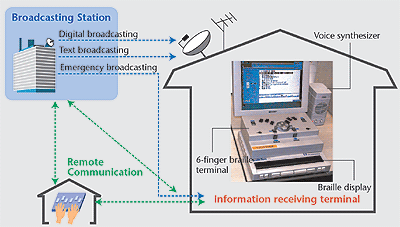|
Toward Barrier-Free Broadcasting
 |
Tadahiro SAKAI,
Senior Research
Engineer,
Human Science |
I started working in research and development at the
NHK (STRL in 1982, and have been studying human-friendly broadcasting
technologies. Specifically, I have been developing an information
display device for visually impaired people. I have evaluated
a Braille presentation method that considers the characteristics
of tactile sense, and have developed a receiving terminal
that reproduces data broadcasts by auditory and Braille means.
One recent problem has been how to convey information regarding
the GUI environment, such as the computer's data broadcasting
menu screen. Using space recognition by tactile sense, we
aim to study multi-modal GUI access methods involving aural
and tactile senses, and to convey graphs and two-or three-dimensional
shapes. |
We have been researching an information-receiving terminal designed
to enable visually impaired people to acquire broadcasting and other
communications information.
Currently in Japan, there are around 360,000 visually impaired people,
but only one-tenth of them can read Braille. There are also 20,000
to 30,000 people who are both visually and aurally impaired, and
for them, touch is the only way to acquire information.
A new Braille presentation method was therefore devised to enable
the visually and aurally impaired to acquire information in Braille,
including those just beginning to learn the script. In this method
(six-finger Braille), each of the six points that make up a conventional
Braille letter is distributed to one of six fingers as shown in
Figure l. The presentation pattern of six-finger Braille is similar
to the layout of the Braille typewriter used by the visually impaired,
and is highly compatible with finger Braille, which is one of the
communication methods used by the visually and aurally impaired.
Also, because the dots are widely spaced, the Braille is easier
to read.
Figure 2 shows the outline and functions of an information-receiving
terminal that conveys textual data to a visually impaired person.
This terminal is equipped with a conventional Braille display for
those who can read Braille, a voice synthesizer for those who cannot,
a six-finger Braille terminal, and a screen monitor. The screen
monitor can display enlarged characters for those with weak sight.
By selecting from these output devices, the majority of the visually
impaired will be able to receive information services.
As Figure 2 shows, the terminal can receive a variety of textual
information, including text broadcasts and emergency broadcasts
that transmit such information as evacuation routes in cases of
disaster. It also incorporates a remote communications function
that permits communication between persons with both visual and
aural impairments, or between a person with these impairments and
a normal person over a telephone line. This function facilitates
interactive participation in broadcasting programs, and lowers the
communications barrier for those with visual and aural impairments.
In the future, we expect this terminal to be introduced into a broadcast
reception system so that the physically impaired people can enjoy
a rich variety of digital broadcast services.
 |
 |
| Figure 1: Principle of the 6-finger
Braille method |
Figure 2: Outline of the information
receiving terminal |
|
|

